Driving Digital Transformation with Tableau Blueprint
Modern analytics are key for digital transformation, but leaders need to carefully manage change across the organization—learn how with Tableau Blueprint.
With data a known keystone of digital transformation, modernizing your analytics is a vital move in our digital age. But to successfully transition from traditional to modern BI, leaders like you must hone an essential skill: managing organizational change. Change is often met with strong resistance, which can put your investment at risk.
Through understanding the process of commitment to change—in conjunction with Tableau Blueprint—leaders can effectively gain buy-in, ensure a successful implementation of Tableau for modern analytics, and secure their digital transformation.
Start with Tableau Blueprint
Each day organizations around the world introduce their employees to Tableau to fulfill their vision of becoming a data-driven organization. The most actionable way to begin this transformation starts with Tableau Blueprint, a step-by-step methodology for organizations that guides executives and empowers people to make better decisions with data.
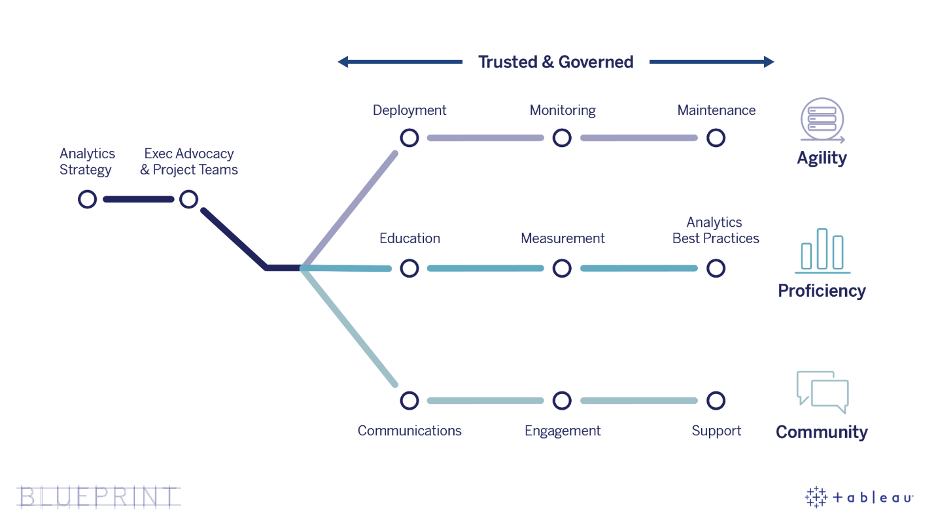
During the first stages of Tableau Blueprint, organizations establish a clear and strong vision for their Analytics Strategy and identify Executive Sponsors and Project Teams.
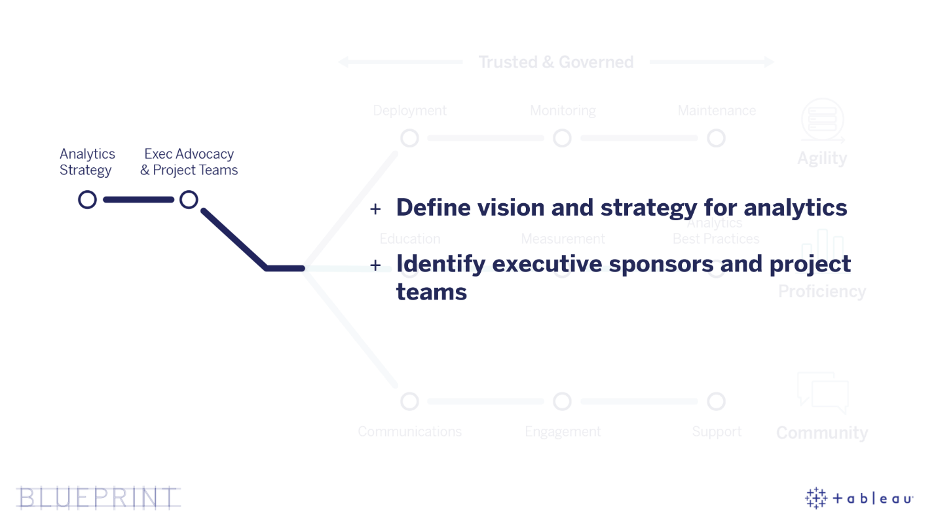
Developing an Analytics Strategy is a key driver for success and creates a unified answer to, “What are we trying to achieve?” Establishing clarity for your organization’s vision to change will help unite teams and drive future objectives.
The next step of Tableau Blueprint is to identify Executive Advocacy and Project Teams. This stage will define stakeholders, executive sponsors, communication leads, and specific administrators to delegate tasks throughout this process.
After these steps have been completed, your organization will have a clear vision of what needs to be accomplished and who will empower your users for success. Next, we focus on how best to implement this vision.
Resistance to change
A common misstep for many organizations is to simply deploy Tableau to users with little or no communication or training. Regardless of how logical and beneficial the change is to the organization, Executive Sponsors quickly find that this change to Tableau can be met with immense resistance from employees and can present a critical risk to your organization’s new investment and vision for digital transformation.
Why is there so much resistance to such a rational decision? The answer is simple: Humans are not designed to be logical beings and we often make decisions based on emotion. Humans also have a tendency to develop emotional connections with things we have a strong familiarity with—this includes our logic-based data tools.
It sounds silly, but the connection makes sense. People spend 40 hours or more each week working with these tools that help provide quality of life for themselves and their families. We form a familiar relationship with these tools and shifting from this norm is routinely, and understandably, met with opposition.
One of the best experiences I have encountered of this phenomenon came when we were consulting a group of new Tableau Creators at a large retail company, all of whom had ample experience with a traditional BI tool.
We were asked to provide guidance for a dashboard that took over 17 seconds to render. Through the implementation of Tableau best practices, we were able to redesign the dashboard with a new load time of less than one second. Thinking this was a slam dunk, we triumphally reported this improvement to the team and their Vice President of Technology. However, to both our and the VP’s surprise, the new design was rejected by the team lead.
The reason? It didn’t look like the old report. Even though the new, modern design was 1600% faster, the team still rejected it purely because it was different and new. This was not a decision based on logic, but rather driven by emotion and a resistance to change.
Ensuring commitment to change
So, how do we best transition from old to innovative?
How do we avoid disengagement and empower people to fulfill your organization’s vision?
The solution is to understand how users react to change and recognize the potential difficulties of the commitment process.
You may be familiar with the Commitment Model originally created by Conner, Harrington, and Horney (1999) that illustrates how commitment to change grows over time. Below is an adaptation of this model based on my experience across hundreds of engagements.
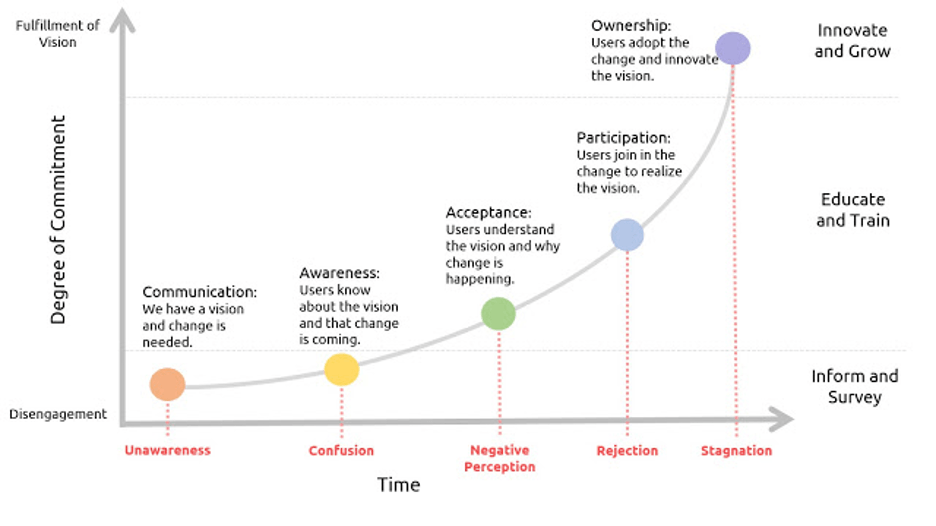
The first certainty I have found throughout my engagements is that Tableau Blueprint Executive Sponsors are paramount in driving commitment to change.
Consistent communication and establishing awareness are essential to avoid confusion and undue stress. It is then through education and training that user acceptance and participation are achieved to ultimately reach your vision’s goal of ownership, innovation, and growth.
Organizations can easily integrate the different stages of the commitment process into Tableau Blueprint’s Proficiency and Community workstreams.

Step 1: Communication
“We have a vision and change is needed.”
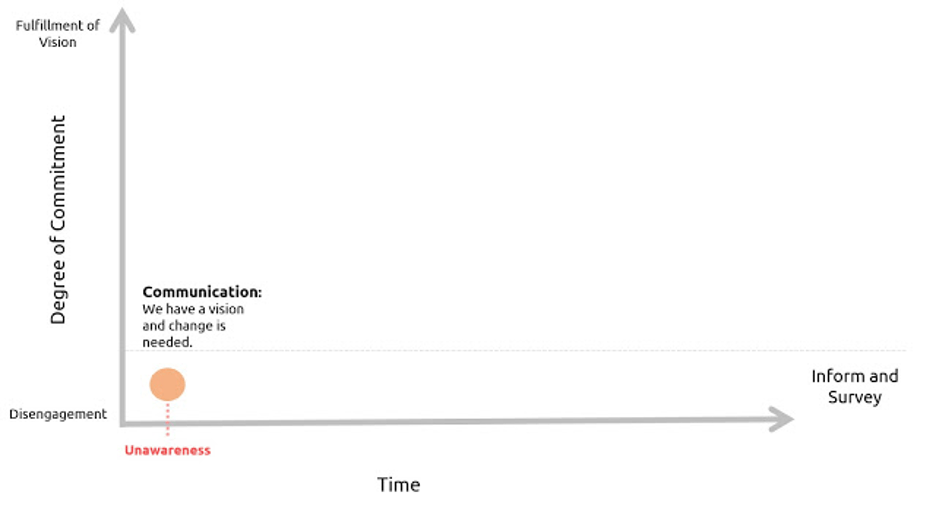
Blueprint Workstream: Community
Blueprint Community Stage: Communications
Goal: Awareness
Accomplish by: Informing the users
Pitfall: Unawareness
Communicating your vision to your organization is the single most important step that many leaders fail to complete. People are better suited for change management when organizations are transparent with the end goal and why the change is happening.
Many organizations may choose to have the CEO or CIO send out an email communication or address the vision in an organization-wide meeting, describing the commitment to become more data-driven or to increase analytics capabilities. This message is then then echoed by the Executive Sponsors. Communication that emphasizes that users are the ultimate owners of this change can instill a sense of comfort in times of stress.
Step 2: Awareness
“Users are aware of the coming change and we will mitigate confusion by understanding the correct approach to take.”
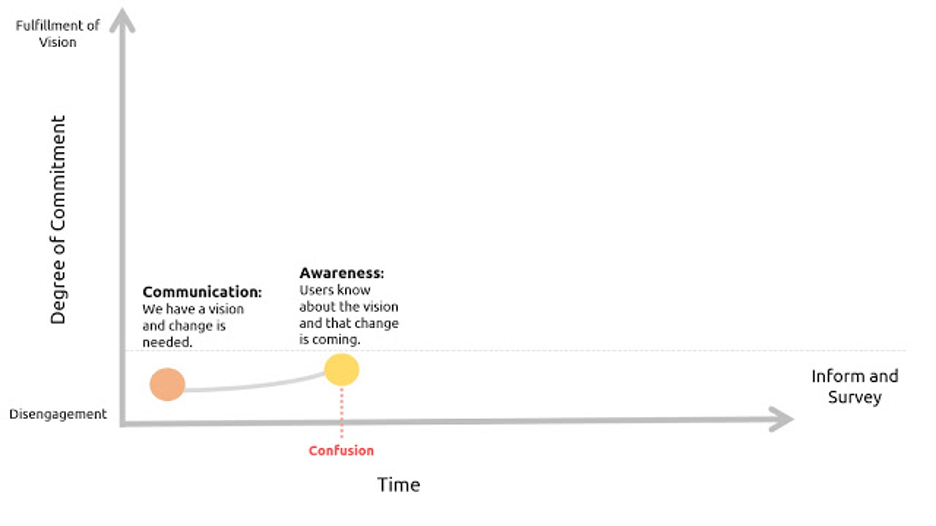
Blueprint Workstream: Community
Blueprint Community Stage: Communications
Goal: Acceptance
Accomplish by: Surveying the users
Pitfall: Confusion
Once people are aware of the vision and the needed change, we can begin to ask more about the status quo and the best approach to avoid confusion and promote understanding of the change.
- What do you like about the current solution?
- What are the gaps of the current solution?
- Do you have prior experience with Tableau?
- How do you feel about the change?
Being able to address concerns and formulate a proper plan for education and training for onboarding with Tableau will minimize the confusion and stress of switching to a different solution. Executive Sponsors should continue to reiterate the vision and why the change is happening, evolve approaches to the employees based on survey results, and communicate how this change will improve their experience. The next step is to gain user acceptance.
Step 3: Acceptance
“Users understand the vision, why the change is happening, and we will continue to demonstrate how this change is beneficial for users.”
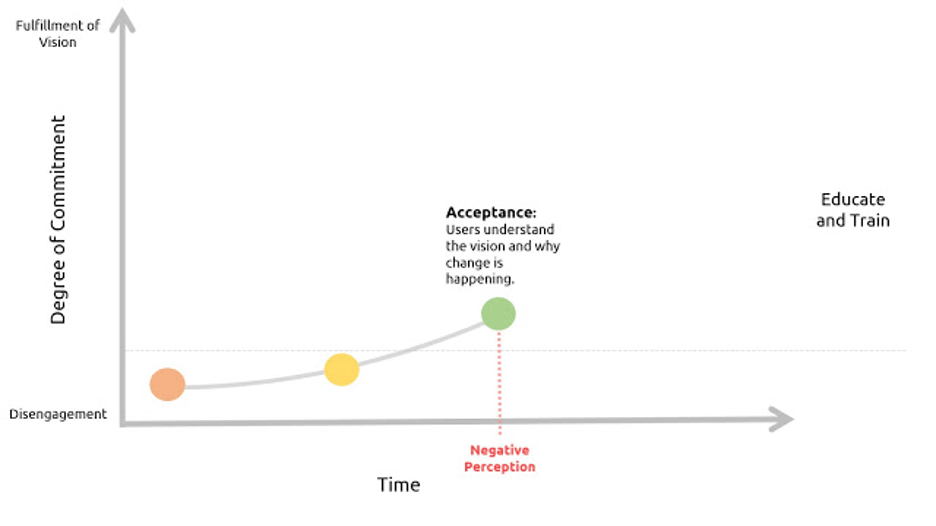
Blueprint Workstream: Proficiency
Blueprint Proficiency Stage: Education
Goal: Participation
Accomplish by: Education of data visualization and Tableau concepts
Pitfall: Negative Perception
Everyone knows that Tableau is different, but what does that mean for your users? For most organizations, the switch to Tableau is not just a software change but a complete paradigm shift. Many people mistakenly assume that crosstabs and text tables are effective, but this has been thoroughly disproven as an intuitive way for humans to understand data.
Educating your employees about the benefits of data visualization is a critical prerequisite for user acceptance and a positive sentiment of Tableau.
If this step is skipped, Tableau can be met with a strong negative perception, and subsequently, the overall vision can suffer.
Step 4: Participation
“Users are involving themselves in the change and training on how to correctly use Tableau.”
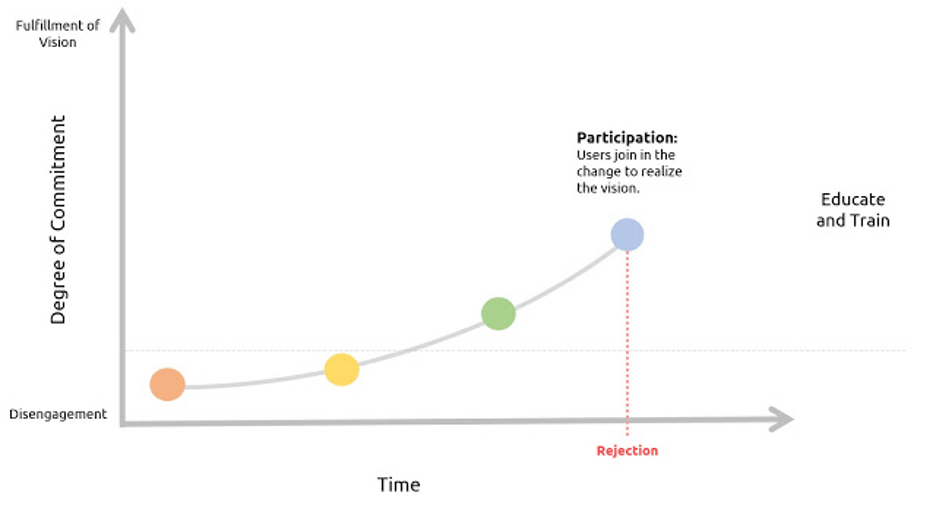
Blueprint Workstream: Proficiency
Blueprint Proficiency Stage: Education
Goal: Ownership
Accomplish by: Training
Pitfall: Rejection
Some pessimism is unavoidable in any change—and learning curves will always exist. Allow adequate time for training and encourage honest feedback.
This is a crucial time to closely involve Executive Sponsors as well as official Tableau Training and Tableau Professional Services to safeguard your investment.
The Tableau Training and Professional Services teams not only help implement Tableau best practices, but they also elevate your user experience and ensure your modern analytics vision is a success. The most common misstep that we encounter at this stage of implementation is when people with years of experience in other data analytics tools try to apply the same logic to Tableau. This frequently results in bloated queries and poor performance. However, with proper training and Professional Services, your team is better enabled to facilitate a successful implementation and a more positive user experience.
Step 5: Ownership
“Users have adopted the change, advocating for our vision, and finding ways to innovate and grow.”
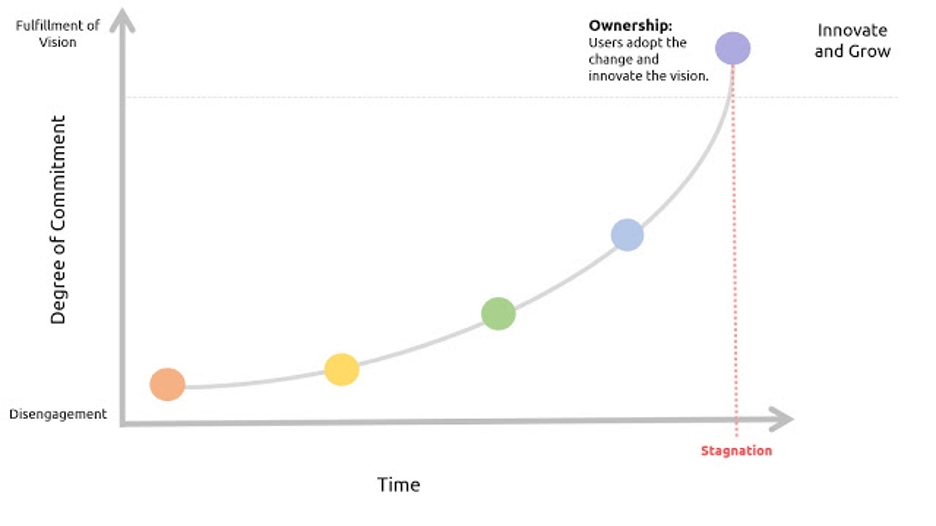
Blueprint Workstreams: Proficiency and Community
Blueprint Proficiency Stage: Measurement
Blueprint Community Stage: Engagement
Goal: Fulfillment of Vision
Accomplish by: Innovation and Growth
Ownership is the ultimate goal for digital transformation in all organizations. In the Measurement stage of the Proficiency workstream in Tableau Blueprint, we measure user adoption and engagement through the utilization of Tableau Server or Tableau Online. In the Engagement stage of the Community workstream in Tableau Blueprint, Executive Sponsors can find new ways to grow and innovate your organization’s data journey with continued involvement and community engagement.
Change is constant
“In times of change, learners inherit the earth, while the learned find themselves beautifully equipped to deal with a world that no longer exists.” – Eric Hoffer Every quarter Tableau introduces new features and updates to our products. We at Tableau are constantly evolving and our organization has a steadfast commitment to change encouraged by our Data Culture. We are highly transparent with our communications and training content, and we have built a vast and rich community of learners dedicated to this shared journey. This agility has secured us as a trusted partner in building resilience for the future for organizations across the globe. By continuing to cultivate a thriving Data Culture and commitment to change in your organization, Tableau empowers people to become learners throughout your data transformation, to quickly discover insights and make better decisions during times of constant change.
Learn more about Tableau Blueprint and get started on your Tableau Blueprint Assessment.
Articles sur des sujets connexes
Abonnez-vous à notre blog
Obtenez les dernières nouvelles de Tableau dans votre boîte de réception.









